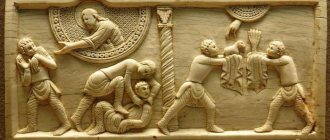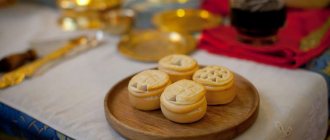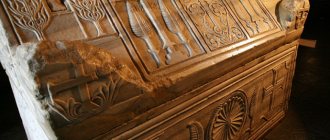Since ancient times, incense has been used in religious rituals. As a result of this peaceful sacrifice, accompanied by the burning of incense in a special incense burner, fragrant smoke rose straight to the sky and conveyed the requests of believers to God.
In Old Testament times, not a single church service was complete without burning incense. It was believed that its aroma helps to cleanse the temple space from any negative influence. The priests classified the duty of censing as a sacred rite. Therefore, it was strictly forbidden for ordinary people to burn incense for other purposes.
What is incense
Incense has much in common with incense, which, according to legend, consisted of 11 different incense (Song of Songs 4:4). This is also a multi-component mixture, the basis of which was invariably 4 main components, which will be discussed below.
The composition was prepared as follows:
- The base mixture was enriched with a variety of flowers and aromatic herbs, roots and spices.
- Then, to grind the base, it was pounded in a stone mortar.
- The powder was sealed with oils and precious balms.
- The viscous, pungent-smelling mass was dried and then broken into small “ingots.”
The fragrant substance was kept in linen bags, from where the clergy personally took it out to burn incense during the liturgy.
Origin of the word
The word “incense” owes its origin to the Greek verb θυμίαμα, translated into Russian meaning “burn” or “smoke.” Of course, we are not talking about smoking in the generally accepted sense, but about burning an aromatic mixture in the altar or censer of the priest during prayer.
Meanings of the concept
The word “incense” also has a second meaning - this is that pleasant, incomparable smoke that the fragrant mixture emits when lit.
Each incense was a special, bloodless form of sacrifice to God. Many centuries before the formation of the Old Testament tradition, most ancient cultures already widely used the burning of a mixture of aromatic herbs and oils in order to convey their prayers and gain God's favor.
At the same time, the smoking of incense was performed in ancient times not only in temples, but also during ceremonies at the courts of royalty and in the homes of very rich people. That is why the phrase “smoke incense” is still used in a figurative sense, ironically emphasizing a flattering, servile attitude towards someone.
The Problem of Uzziah and Zechariah
Scripture says; “I wish that men would say their prayers, raising clean hands without anger or doubt.” What was Uzziah and Zechariah's problem?
Superiority complex, a consequence of pride and self-focus. “I am a king, I can be a priest if I want, I know how to offer incense.” This complex manifested itself through anger. Uzziah was constantly irritated.
Zechariah's main problem was doubt - this is also a focus on oneself.
(Luke 1:18) And Zechariah said to the angel, By what shall I know this? For I am old, and my wife is advanced in years.
Doubt takes this form. God tells you to do something, you say: “I can’t, I’m old.” This is forgetfulness and disregard for everything that God says. This is self-focus. If God pleases, He will renew and rejuvenate.
Composition of biblical incense
The Holy Scripture says that the prophet Moses received instructions regarding the composition of incense from the Lord Himself. This happened while climbing Mount Sinai, where he received the tablets of the Covenant with the Ten Commandments.
The Lord commanded Moses to take equal parts of “stakti, onycha, fragrant halvan and pure frankincense.”
(Ex. 30:34–36) and make a smoking mixture from it. Let's take a closer look at each of the components.
Lebanon
In pharmacology it is known under the Latin name Olibanum.
This fragrant tree resin has long been collected from trees in the East. The resin taken from the Lebanese cedar was especially valued - hence its name, which in Russian was gradually transformed into “incense”. They collected it like this: in early spring, small cuts were made on the trunk, from which resinous, aromatic “juice” flowed abundantly. It froze in the form of oblong fragments - they were separated from the bark and sorted.
Pure selected incense has a pale yellow or pinkish tint with a characteristic matte-waxy sheen at the break and has a specific balsamic aroma. When heated, the incense softens but does not melt. Slightly soluble in water.
In Russia, Lebanon was called “dewy incense.” Merchants from eastern countries brought it to the country; it was expensive and valued very highly.
Stacti
The word is of Greek origin and is translated into Russian as “dripping.” The resinous, fragrant substance comes out of the tree by gravity (without cutting the bark) - hence the name.
According to the majority of interpreters of the Holy Scriptures, including St. Basil the Great, we are talking about myrrh - a resin that comes from a plant of the genus Commiphora myrrha.
Some researchers believe that the Scripture may be talking about the resin of shrubs of the Styrax family, widespread in the tropics.
About them
In Greek, onychos means nail. The so-called operculum - horny convex caps, designed to protect the soft bodies of mollusks from external influences - have a nail-like shape.
The operculum of a number of mollusks (for example, the genus Tricornis, inhabiting the Red Sea) emit a strong, specific aroma. Powder from them has been used since ancient times to prepare fragrant smoking compounds.
Halvan
This plant of the Apiaceae family, otherwise called galbanum, grows in Iran, Libya and Afghanistan. When cut, the stems and roots of galbanum begin to intensively secrete a resinous liquid with a pleasant woody-balsamic smell. The plant does not live long, only a couple of weeks, after which it dries out.
It is not easy to cultivate and collect, hence the high price of raw materials, so beloved by perfumers. To determine the amount of galbanum in their compositions, aromatics use the smallest doses - such is the concentration of the odorous substance in this plant.
Maria
(Luke 1:34) Mary said to the angel: How will this be, since I do not know the husband?
She had no doubt that this would be done. She asks: “How?” Mary speaks of a method, and Zechariah speaks of an impossibility.
What is Zechariah's problem? In his doubt. Look at Angel's answer.
(Luke 1:19) I am Gabriel, who stands before God, and was sent to speak with you and bring this good news to you; and behold, you will remain silent and will not be able to speak until the day this happens, because you did not believe my words, which will come true in due time.
In this case, God shut Zechariah's mouth so that he would not interfere with his wife's pregnancy. Because our words can both create and destroy. Zechariah forgot the meaning of his name and the meaning of his wife Elizabeth's name.
Zechariah - The Lord remembers.
Elizabeth is God's promise.
They had a son, John - grace.
There is a message here: God remembers His promise and has given grace.
When you forget God's promises, you begin to doubt. When you pray, remember God's promises. When you pray, remember Uzziah, because his strength did not come from himself, but from the Lord. Zechariah forgot that the Lord remembers His promises and will always give grace.
What is it needed for
The main purpose of incense is to provide fragrant smoke during worship. Lighted charcoal is placed in a sacred metal vessel (censer, censer), on top of which incense is placed. During combustion, it emits light, aromatic smoke.
The censing is carried out at the most solemn moments of the liturgy. If incense occurs according to the full rite, the priest goes around the entire temple. Small censing is performed only in front of the altar (or iconostasis).
Each component in the censer is symbolic. Fire denotes the Divine nature of Jesus Christ, coal reflects His human nature, and smoke from incense represents the pure prayers of people raised to God.
Angel and Mary
(Luke 1:30) And the Angel said to Her, Fear not, Mary, for You have found favor with God; and behold, you will conceive in your womb and give birth to a Son, and you will call His name Jesus. He will be great and will be called the Son of the Most High, and the Lord God will give Him the throne of His father David; and He will reign over the house of Jacob forever, and His kingdom will have no end.
(Luke 1:38) Then Mary said, Behold, the handmaid of the Lord; let it be done to me according to your word. And the Angel departed from Her.
All faith is in the word of God, and not in your own capabilities. You place your faith on the word that gives you the promise. In this word, all the power is for its own fulfillment. Be at peace. The Word has the power, not you.
Here we can learn:
- Don't get angry like Uzziah.
- Don't doubt like Zechariah.
Application of incense
Today, when the recipe for making incense has changed and the ingredients have become much cheaper, aromatic mixtures based on wood resins are used not only during religious services. Medicine, perfumery, cosmetology - this is not a complete list of areas where the unique properties of fragrant compositions have been used.
Inhaling the “aroma of heaven” (as our distant ancestors called incense) calms, puts you in a positive mood, and helps to cope with emotional instability. The smoke from smoking aromatic mixtures has a beneficial effect on the brain, stimulating memory and negating the effects of stress.
Essential oils and tree resins included in ointments to relieve joint pain have shown excellent results for many decades. Thanks to the anti-inflammatory properties of the mixtures, colds and runny nose go away faster and easier, and the functioning of the cardiovascular system improves.
To ease breathing, perform five-minute inhalations with three drops of frankincense oil. For cardiac ailments, a light massage of the corresponding area with olibanum is recommended, and for headaches - the temporal and parietal areas of the head.
By enriching an industrial shampoo or cream with just a few drops of your favorite aromatic mixture, you will receive an effective cosmetic product. At the same time, it will delight you not only with its silky structure and pleasant smell.
As a result of using cosmetics with natural essential oils, the following wonderful metamorphoses occur:
- improves complexion;
- the skin is cleared of acne;
- the turgor of the dermis increases, as a result of which small wrinkles disappear;
- in the case of hair, there is a thickening of the diameter of the shaft and the awakening of dormant follicles.
There are no direct contraindications to the use of aromatic mixtures, with the exception of individual intolerance. The only advice that can be given to those who want to try their miraculous properties for themselves is not to overdo it. The optimal dosage of input should not exceed 7 drops of oil per 100 ml of base product.
Incense is truly a gift from God to man. Its pure and sweet aroma not only raises prayer requests to heaven, but gives us health and beauty, brings peace to the house and pacifies the soul.
Purpose
Incense has been used in different ways at different times. He was endowed with all sorts of properties. There are several interesting facts about the purpose and use of incense among different religious denominations and peoples in the past:
- In ancient Egypt, incense was especially revered. They smoked it for almost any occasion. Believing that people were surrounded by Gods everywhere, the Egyptians burned incense daily in their homes as proof of their worship. In this historical region there was even a proverb: “The gods love incense”;
- In the Jerusalem Temple, only the priests burned incense. And this was their direct responsibility. Smoking incense was strictly forbidden to ordinary Israelis. According to the Holy Book of the Jews, such people were disgusting to Jehovah (God). They burned incense on a special altar 2 times a day. And on the greatest holiday for the Jews, “Day of Atonement,” the high priest burned incense in the Holy of Holies;
- Even in ancient times, the Israelis developed the concept of incense prayer. Since believers sincerely believed that when burning incense, God always hears the prayers being read;
- The early Christians probably did not use incense at all, since it was believed that it was a symbol of paganism. The pagans threw small pieces of aromatic substances onto the altar, thereby demonstrating their worship
Incense is not forgotten even today by almost any people. It is actively used in various rituals and services:
- in churches, fragrant substances are burned during liturgy and prayer;
- Narrow religious communities, when performing rituals, burn incense to contact supernatural forces (sessions of spiritualism)
- adherents of Islam burn incense in houses in front of the altar and in churches. Thus, they express worship of God and protect the dead;
- It's not just believers who burn incense. Not so long ago it began to be actively used in meditation. Thematic reference books suggest using an aromatic substance to fill with energy and achieve a subtle level;
Modern Christians do not burn incense in its original form. But they praise incense excessively in their prayers. It is believed that righteous worship of God is equivalent to the fragrance of an aromatic substance.
Skeptics use the smoke of hot incense too. They only pursue a purely practical goal. Aromatic resin is an incense that has a specific but very pleasant smell. Therefore, some people burn incense in their homes solely to spread the aroma into the home.
Use of the expression in literature
- “I smoked incense for others, But I carried you in the shrine of my heart” (Baratynsky) - “Already bird cherry incense flows there in the clean air” (Baratynsky) - “On Sundays, all the grooms appeared in a whole flock and courted, said pleasantries, laughed, smoked for the bride and her mother’s incense” (Gorky’s “The Peasant”) - “Let me introduce you to my friend... he devoted himself to the (distillery) business of his parent. Meanwhile, he still loves to smoke incense - on the altar of poetry" (Nadezhdin "The Host of Nihilists") - "Blue smoke was still flowing from the censers of motionless incense" (Apukhtin) - "Wash his inspired head with a soft wave of incense" (A. Turgenev)
What is dissonance? What is Abyssus abyssum invocat? What is Ab ovo?
Proper smoking
There are no strict rules regarding proper smoking of incense today. Incense is burned not only during worship, but also during meditation, aromatherapy and even treatment.
If we talk about the traditional rules for burning incense, then this was usually done in a special vessel - a bowl, and in church - a censer. The censer has long been considered a sacred vessel and was used only at solemn liturgical events.
Frankincense is used to make religious incense candles. But they are not only smoked in churches. Non-believers also buy candles for the purpose of lighting them at home. Where can you buy such aroma products? You can't find them in mass markets. Candles can be purchased at specialty incense stores.
There is an opinion that if you often light an incense candle, you can be cured of a number of diseases. But this has not been scientifically proven.
Now there is also cigarette incense. It is added to tobacco. Smoking incense can also be found in hookah bars.










